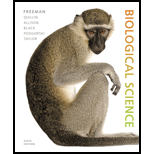
Concept explainers
Which of the following occurs when a covalent bond forms?
a. Electrons in valence shells are transferred from one atom to another.
b. Electrons in valence shells are shared between atoms.
c. Partial charges on polar molecules interact.
d. Nonpolar molecules are pushed together by surrounding water molecules.
Introduction:
Covalent bonds are formed by sharing of the electron pairs between atoms. These electron pairs are referred to as shared pairs or bonding pairs. The chemical bond in which the complete transfer of electron present in the outer shell takes place is known as an ionic bond.
Answer to Problem 1TYK
Correct answer:
Electrons in valence shells are shared between atoms.
Explanation of Solution
Explanation/Justification for the correct answer:
Option (b) is given that the bond is formed by the electron sharing. Covalent bonding occurs when pairs of electrons are shared between atoms. Atoms are covalently bond with other atoms by forming a full electron shell providing more stability. By sharing their outer most (valence) electrons, atoms can fill up their outer electron shell and gain stability. Hence, option (b) is correct.
Explanation for incorrect answers:
Option (a) is given that the valence shells are transferred. The chemical bond, in which the complete transfer of electron present in the outer shell occurs is known as an ionic bond. So, it is incorrect answer.
Option (c) The polar molecules have partial charges present on them, the interaction of the two-partial charged atoms results in the formation of the dipole-dipole interaction. It takes place when two molecules carry opposite partial charge. So, it is incorrect answer.
Option (d) The interaction between the water and the non-polar molecule, in which the non-polar molecules attract themselves is known as hydrophobic interaction. These molecules do not form bonding with the water molecules, as a result, they are forced to interact among themselves. So, it is incorrect answer.
Hence, options (a), (c) and (d) are incorrect.
Covalent bonds are formed when electrons are shared between atoms.
Want to see more full solutions like this?
Chapter 2 Solutions
Biological Science (6th Edition)
- In one paragraph show how atoms and they're structure are related to the structure of dna and proteins. Talk about what atoms are. what they're made of, why chemical bonding is important to DNA?arrow_forwardWhat are the structure and properties of atoms and chemical bonds (especially how they relate to DNA and proteins).arrow_forwardThe Sentinel Cell: Nature’s Answer to Cancer?arrow_forward
- Molecular Biology Question You are working to characterize a novel protein in mice. Analysis shows that high levels of the primary transcript that codes for this protein are found in tissue from the brain, muscle, liver, and pancreas. However, an antibody that recognizes the C-terminal portion of the protein indicates that the protein is present in brain, muscle, and liver, but not in the pancreas. What is the most likely explanation for this result?arrow_forwardMolecular Biology Explain/discuss how “slow stop” and “quick/fast stop” mutants wereused to identify different protein involved in DNA replication in E. coli.arrow_forwardMolecular Biology Question A gene that codes for a protein was removed from a eukaryotic cell and inserted into a prokaryotic cell. Although the gene was successfully transcribed and translated, it produced a different protein than it produced in the eukaryotic cell. What is the most likely explanation?arrow_forward
- Molecular Biology LIST three characteristics of origins of replicationarrow_forwardMolecular Biology Question Please help. Thank you For E coli DNA polymerase III, give the structure and function of the b-clamp sub-complex. Describe how the structure of this sub-complex is important for it’s function.arrow_forwardMolecular Biology LIST three characteristics of DNA Polymerasesarrow_forward
 Human Biology (MindTap Course List)BiologyISBN:9781305112100Author:Cecie Starr, Beverly McMillanPublisher:Cengage Learning
Human Biology (MindTap Course List)BiologyISBN:9781305112100Author:Cecie Starr, Beverly McMillanPublisher:Cengage Learning
 Concepts of BiologyBiologyISBN:9781938168116Author:Samantha Fowler, Rebecca Roush, James WisePublisher:OpenStax College
Concepts of BiologyBiologyISBN:9781938168116Author:Samantha Fowler, Rebecca Roush, James WisePublisher:OpenStax College Biology Today and Tomorrow without Physiology (Mi...BiologyISBN:9781305117396Author:Cecie Starr, Christine Evers, Lisa StarrPublisher:Cengage Learning
Biology Today and Tomorrow without Physiology (Mi...BiologyISBN:9781305117396Author:Cecie Starr, Christine Evers, Lisa StarrPublisher:Cengage Learning Biology (MindTap Course List)BiologyISBN:9781337392938Author:Eldra Solomon, Charles Martin, Diana W. Martin, Linda R. BergPublisher:Cengage Learning
Biology (MindTap Course List)BiologyISBN:9781337392938Author:Eldra Solomon, Charles Martin, Diana W. Martin, Linda R. BergPublisher:Cengage Learning





